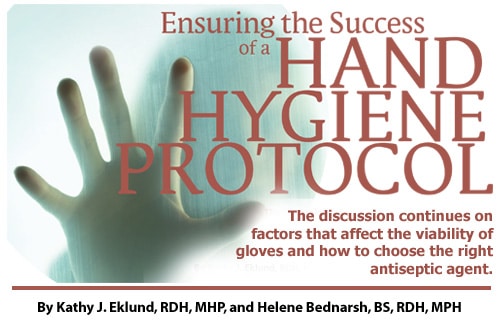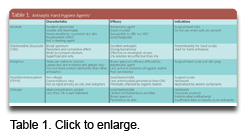
Ensuring the Success of a Hand Hygiene Protocol
The discussion continues on factors that affect the viability of gloves and how to choose the right antiseptic agent.

HAND LOTIONS AND MOISTURIZERS
One of the primary defenses against infection is healthy, intact skin. Hand lotions and moisturizers are recommended to prevent skin dryness, which can compromise the integrity of the skin. However in selecting a lotion, the compatibility of the lotion, the antiseptic product(s) used, and the effect of petroleum or other oil emollients in the lotion on gloves must be considered. Petroleum-based lotions can weaken gloves and increase permeability. A petroleum-based product should only be used at the end of the workday when clinical tasks have been completed. Hand hygiene technique, such as using cool to luke-warm water and thoroughly drying hands after washing, is also important in reducing skin dryness and irritation.1
FINGERNAILS AND ARTIFICIAL NAILS
Maintaining the integrity of gloves is necessary for them to perform as a protective barrier between a dental health care worker (DHCW) and the microbial environment. Therefore, the Centers for Disease Control and Prevention (CDC) recommends keeping fingernails short with smooth, filed edges to allow thorough cleaning and prevent glove tears. Artificial fingernails are not recommended since they may act as a suitable environment for microbial growth.2 They have also been associated with fungal and bacterial outbreaks in hospital settings.2 Freshly applied nail polish on natural nails does not increase the microbial load from periungual (around the nail) skin if fingernails are short. However, chipped nail polish can harbor added bacteria.2
JEWELRY
Little scientific evidence exists on the effects of wearing jewelry on hand hygiene or glove integrity. However CDC suggests that the use of hand or nail jewelry may make putting on gloves more difficult and may compromise the fit and integrity of the glove. Hand or arm jewelry can harbor microorganisms and lead to colonization of resident microorganisms of the skin. Jewelry may interfere with glove use, eg, impair ability to wear the correct-sized glove or alter glove integrity, and may lead to glove failure, eg, stretching, tearing, etc.1
THE SELECTION PROCESS
Many factors come into play during product selection, such as the overall performance of the product, the persistence, and the acceptability of the product to DHCWs. In addition, cost and availability of the product are important factors. DHCW specific concerns, like chemical sensitivities or allergies; impact on integrity of the skin; and compatibility with other products, such as lotions and gloves, are also key. DHCP and dental practices should select commercially available products that are Food and Drug Administration (FDA) accepted antiseptic hand hygiene agents. This ensures that the preparation is at the appropriate concentration of the active antiseptic ingredient(s).
 Selecting the most appropriate antiseptic agent for hand hygiene requires consideration of multiple factors. Essential performance characteristics of a product (the spectrum and persistence of activity and whether or not the agent is fast-acting) should be determined before selecting a product. Delivery system, cost per use, and reliable vendor support and supply are also considerations. DHCW acceptance is a major factor in compliance with recommended hand hygiene protocols. Considering DHCP needs is critical and should include possible chemical allergies, skin integrity after repeated use, compatibility with lotions used, and offensive agent ingredients like scent.
Selecting the most appropriate antiseptic agent for hand hygiene requires consideration of multiple factors. Essential performance characteristics of a product (the spectrum and persistence of activity and whether or not the agent is fast-acting) should be determined before selecting a product. Delivery system, cost per use, and reliable vendor support and supply are also considerations. DHCW acceptance is a major factor in compliance with recommended hand hygiene protocols. Considering DHCP needs is critical and should include possible chemical allergies, skin integrity after repeated use, compatibility with lotions used, and offensive agent ingredients like scent.
The 2002 CDC Guideline for Hand Hygiene in Healthcare Settings identified five primary active ingredients in antiseptic hand hygiene products: alcohols, chlorhexidine gluconate (CHG), iodophors, parachlorometaxylenol (PCMX), and triclosan.2 See Table 1 for more details.
STORAGE AND DISPENSING OF HAND CARE PRODUCTS
The CDC recommends storing liquid hand care products in either disposable closed containers or closed containers that can be washed and dried before refilling. Neither soap nor lotion should be added to a partially empty dispenser. Allow the dispenser to be depleted and then dispose or thoroughly clean and dry before reuse if not single-use disposable. Due to the nature of these agents—including plain soap and antiseptic products—they may become contaminated or support the growth of organisms. Store and dispense products according to manufacturers’ directions.2
BEST PRACTICES FOR HAND HYGIENE
Each dental health care setting must develop clear policies and procedures consistent with current guidelines and recommendations from CDC and other authoritative agencies. A major challenge for any site-specific infection prevention and control program is to monitor and facilitate adherence to these policies and procedures. Today, many resources are available to facilitate individual practice settings hand hygiene programs including the CDC (www.cdc.gov/handhygiene and www.cdc.gov/oralhealth) and the Organization for Safety and Aspepsis Procedures (www.osap.org).
REFERENCES
- Kohn WG, Collins AS , Cleveland JL, Harte JA, Eklund KJ, Malvitz DM, Centers for Disease Control and Prevention (CDC). Guidelines for infection control in dental health-care settings—2003. MMWR Recomm Rep. 2003;19;52(RR-17):1-61.
- Boyce JM, Pittet D, Healthcare Infection Control Practices Advisory Committee, HICPAC/SHEA/APIC/IDSA Hand Hygiene Task Force. Guideline for hand hygiene in health-care settings. MMWR Recomm Rep. 2002;51(RR-16):1-45, quiz CE1-4.
From Dimensions of Dental Hygiene. March 2007;5(3): 21-22.

